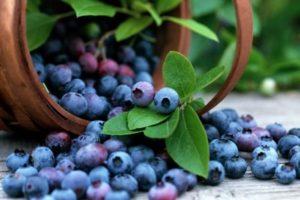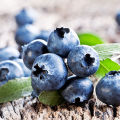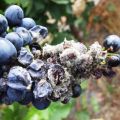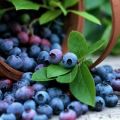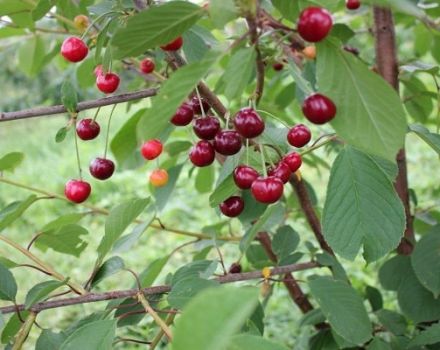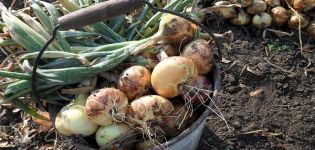Description and characteristics of the Duke blueberry variety, planting and care
The tasty, vitamin-rich blackberry was previously a rare berry found only in the forest. Thanks to the efforts of breeders, the shrub can be planted in the garden. Duke blueberry is one of the best species. The plant is tall, famous for its amazing productivity, resistance to low temperatures. In order to safely grow a bush, you need to familiarize yourself with all the features of the planting technology, care, reproduction.
Description and characteristics of blueberry Duke
The tall shrub has a medium early ripening period and allows you to get a decent harvest, as a rule, the first blueberries can be consumed in the second year after planting. Blackberries have a fibrous rhizome, forming up to 5 shoots per season. Height and circumference is about 2 meters. The bushes are erect, skeletal, in the sun they acquire a brown color.
There are usually few branches, due to which the fruits are well warmed up by ultraviolet rays. They are thin, with a bend, as a rule, as the bush grows, it becomes quite thick. Leaves are oval, up to 8 centimeters long, 4 centimeters wide, with short cuttings.
In accordance with the description of the Duke blueberry, in the fall it acquires a red tint, is collected in a brush up to 10 pieces with the shape of a bell 1 centimeter wide. Blueberries need insect pollination to ensure a decent harvest. The procedure increases the size of the berries, stimulates their rapid ripening and guarantees the symmetrical shape of the fruit.
Blueberries are large, rounded, 20 * 12 millimeters in size, not uniform. Weight reaches 2 grams. The skin is bluish, with a bluish tinge, smooth. There are many seeds in it, the taste is sweet with a piquant astringency. According to experienced gardeners, the Duke blueberry variety is an economical plant.
Growing history
The Duke blueberry variety was first bred by breeding in America around the end of the 20th century. And by the beginning of the 80s, the berry became available to most gardeners. In nature, blueberry fruits appear after 15 years, and garden species yield yields in the second year.
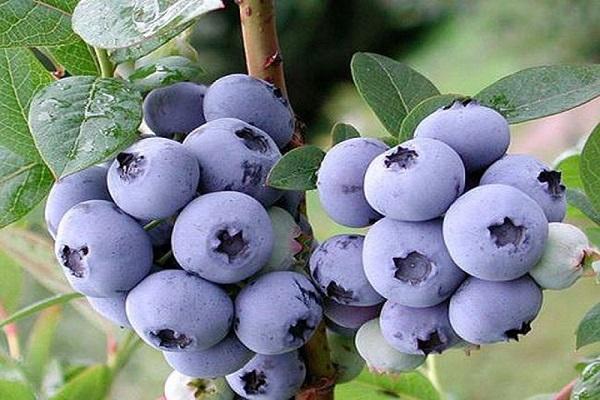
Positive and negative sides
The berry assumes a number of advantages and disadvantages that must be read before planting.
| pros | Minuses |
| Ripens quickly
| Requires a special soil composition, a certain moisture |
| Large fruits | |
| The taste is richly sweet | |
| High yield | |
| Easy to transport | |
| Frost-resistant variety | |
| The bush is rarely exposed to diseases and pests. | |
| It does not require special care |
Growing features
The bush is grown without problems in the northern regions of the countries of the former Soviet Union, where the temperature drops to -40 degrees. Blueberries also thrive in mid-latitudes. They love moisture, require a lot of water to get the entire root system wet.

Site selection
The bush is planted in areas illuminated and warmed by the sun's rays. It also takes root in partial shade conditions, but in low light the fruits will not be as sweet. In the shade, the variety will grow, but not yield, since it needs enough light to form. It is advisable to plant bushes along the fence. Blackberries should not be planted at vegetable growing sites. Areas where grass crops have been growing for many years and where organic fertilizers have not been used are best suited.
Light sandy, sandy loam, sour soils are suitable for this blueberry variety. The roots are located in the surface layer 20 centimeters deep. It is worth choosing a place where groundwater passes at a distance of 60 centimeters from the ground.
Selection of seedlings
2-3 year old seedlings are best suited for growing. You need to buy blueberry seedlings only in the market or specialized stores, where strict control is carried out and professional recommendations can be obtained. Before purchasing, carefully examine the seedlings. It should be like this:

- flexible, not dry branches;
- there are no spots on the bark and leaves, they are a sign of disease;
- the soil ball should be complete, braided with thin roots.
The planting material is sold in peat tanks. It is undesirable to buy it with open roots, they may not take root.
Landing dates
It is advisable to plant blueberries in spring or September. In November, it is better to keep the seedlings in containers, postpone planting work in the spring, so that the seedlings have time to take root. The measures should be carried out after measuring the soil pH in the planned rows and between them. Monitor the indicator regularly.
How to plant blueberries correctly
Shoots are planted in this way:
- bush method - holes are dug 40 centimeters deep, 80 centimeters in diameter, at a distance of 1.5 meters to each other;
- trench method - if there are a lot of seedlings, it is better to plant it in trenches and 50 centimeters wide, 40 centimeters deep, leave 2-3 meters between rows.
Place the rows from north to south.
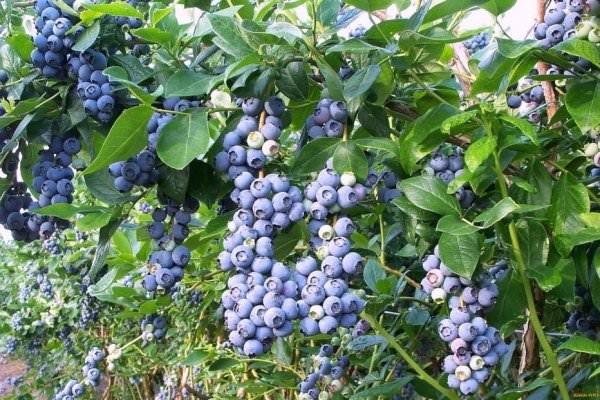
Blueberry Care Tips
Shrubs will bear fruit abundantly if you provide them with comfortable conditions. It is necessary to provide a sufficient amount of watering, dressing, timely cut and prepare for wintering. In addition, it is required to loosen the ground in time, weed between the beds, and remove weeds.
Watering rules
Water the plants with low acidity water. The soil should be soaked before the root system occurs. For large plantations, drip irrigation is optimal - they are installed at a distance of 20-25 centimeters. Excessive moisture is fraught with a lack of air - the roots suffer, are exposed to fungal attacks.
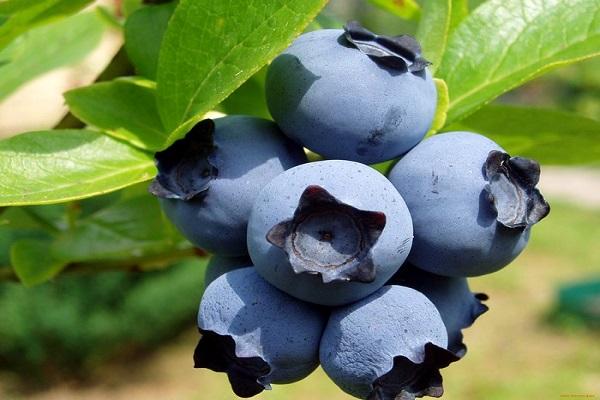
Required fertilizers
It is advisable to feed the plant at the beginning of the growing season at 50%, in 2 doses before flowering and during the setting.
- On industrial plantings, it is necessary to correctly calculate the ratio of the components of the NPK complex, taking into account their concentration in the ground. Chlorine-containing fertilizers are undesirable.
- From organics to give preference to fresh mullein, goat, bird droppings - no. Overripe manure can be used.
- The emphasis is on nitrogen, ammonium nitrate is great for soil, with an acidity of 4.0-4.5.
- On acidic soil, it is better to use urea, ammonium sulfate. Their acidifying properties are weaker.
- Of the dry species, give preference to complex mineral dressings: Florovit, Agrecol. Pre-mix them with the ground, provide full watering.
Do not apply nitrogen after fruiting - this increases the level of shoot growth, and decreases winter hardiness.
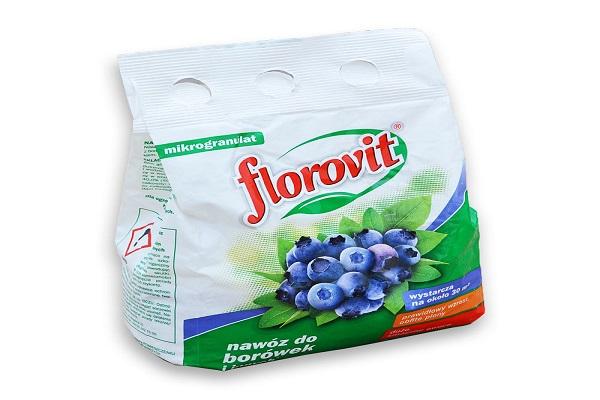
Bush formation
Bushes are pruned in the first 3 years. When the plant is spreading, formative pruning can be done.
- In early March, remove the blind growth on the green cone, thickening the plant and lower branches.
- Of the large annual shrubs, leave 5 of the strongest, excise the rest. Due to such pruning, an erect, spreading bush is formed.
- In plants over 8 years old, yielding poor yields and small fruits, rejuvenating pruning is carried out. Up to 20% of old branches are completely excised, stimulating the development of new ones.
It should be borne in mind that too zealous pruning is dangerous by reducing the number of fruits.
Preparing for winter
In winters with little snow, young bushes can freeze slightly. It is advisable to mulch them in late or mid-autumn. Shelter is done in this way:
- before freezing, mulch the root zone within a radius of 0.5 meters using peat, needles;
- install wire arcs next to the bushes, bend the branches to them and fix with twine;
- before frosts, cover the bush with burlap or agronomic fiber, put spruce branches on top, they will protect blueberries from hares.
From mid-March - remove the insulation, cut off the frozen branches.
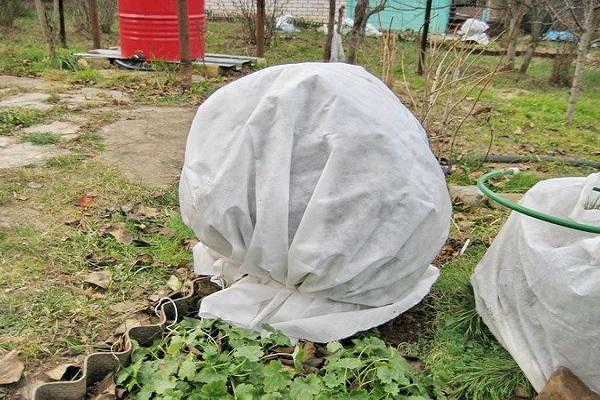
Prevention of diseases and pests
With proper care and planting, the plant is less likely to be affected by pests. To destroy fungal pathologies, fungicide treatment is used in early spring.
Blueberry propagation
Blueberry bushes in nurseries reproduce by seed, but such seedlings yield a harvest after 8 years. The most convenient way is grafting and layering method. The berry is planted on the site after the formation of the root system in 2-3 years.
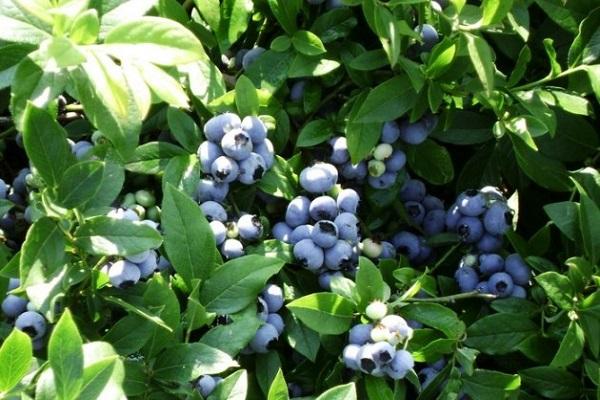
Harvesting and storage
Collect and store the blueberry crop manually or mechanically. To keep the fruit fresh for 2 weeks, it is important not to damage the thin skin. To preserve the crop for a long time, it can be dried, frozen and processed for winter harvesting. Blueberry jam enhances the body's defenses, enriches it with nutrients and warms up in the cold.
